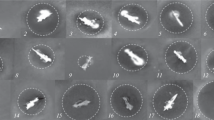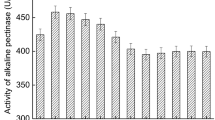Abstract
The fungus Penicillium griseoroseum has the potential for application on an industrial scale as a host for the production of homologous and heterologous proteins, mainly because it does not produce some mycotoxins or secrete proteases under the growth conditions for pectinase production. However, for the fungus to be used effectively as an expression heterologous system, an understanding of the organization of its genome, as well as the mechanisms of gene expression and protein production, is required. In the present study, the size of the P. griseoroseum genome was estimated to be 29.8–31.5 Mb, distributed among four chromosomes. An analysis of plg1 and pgg2 pectinolytic genes expression and copy number in recombinant multi-copy strains of P. griseoroseum demonstrated that an increase in the number of gene copies could increase enzyme production, but the transcription could be affected by the gene integration position. Placing a copy of the plg1 gene under the control of the gpd promoter of Aspergillus nidulans yielded a 200-fold increase in transcription levels compared to the endogenous gene, and two copies of the pgg2 gene produced an 1100-fold increase compared with the endogenous gene. These results demonstrated that transcription, translation, and protein secretion in the fungus P. griseoroseum respond to an increased number of gene copies in the genome. The processing capacity and efficiency of protein secretion in P. griseoroseum are consistent with our premise that this fungus can be used for the industrial-scale production of several enzymes.





Similar content being viewed by others
References
Albersheim P (1966) Pectin lyase from fungi. Methods in Enzymol 8:628–635
Albersheim P, Killias U (1962) Studies relating to the purification and properties of pectin transeliminase. Arch Biochem Biophys 97(1):107–115
Araújo EF, Queiroz MV, Teixeira JA, Gonçalves DB, Bazzolli DMS, Ribon AO, Ribeiro JB (Inventores) (2007) Universidade Federal de Viçosa (Depositante). Linhagem recombinante geneticamente modificada Penicillium griseoroseum T20 com maior produção de pectina liase e poligalacturonase, cassetes de expressão para a construção da linhagem recombinante, preparação enzimática e processo para produção da preparação enzimática. Depósito de pedido de patente. PI 0705573-0
Araújo EF, Silva DO, Queiroz MV, Cardoso PG (Inventores) (2005) Universidade Federal de Viçosa (Depositante). Linhagem recombinante de Penicillium griseoroseum geneticamente modificada com aumento na produção de pectina liase. Depósito de pedido de patente. PI0502515-0
Baracat MC, Valentim C, Muchovej JJ, Silva DO (1989) Selection of pectinolytic fungi for degumming of natural fibers. Biotechnol Lett 11(12):899–902
Baracat-Pereira MC, Coelho JLC, Silva DO (1994) Production of pectin lyase by Penicillium griseoroseum cultured on sucrose and yeast extract for degumming of natural fibers. Lett Appl Microbiol 18:127–129
Bazzolli DMS, Ribon AOB, Queiroz MV, Araújo EF (2006) Molecular characterization and expression profile of pectin-lyase-encoding genes from Penicillium griseoroseum. Can J Microbiol 52(11):1070–1077
Bazzolli DMS, Ribon AOB, Reis KCP, Queiroz MV, Araújo EF (2008) Differential expression of PLG genes from Penicillium griseoroseum: plg1 a pectinolytic gene is expressed en sucrose and yeast extract. J Appl Microbiol 105:1595–1603
Cardoso PG, Ribeiro JB, Teixeira JA, Queiroz MV, Araújo EF (2008) Overexpression of the plg1 gene encoding pectin lyase in Penicillium griseoroseum. J Ind Microbiol Biotechnol 35(3):159–166
Cardoso PG, Teixeira JA, Queiroz MV, Araújo EF (2010) Pectin lyase production by recombinant Penicillium griseoroseum strain 105. Can J Microbiol 56(10):831–837
Chen X, Liang Y, Hua J, Tao L, Qin W, Chen S (2010) Overexpression of bacterial ethylene-forming enzyme gene in Trichoderma reesei enhanced the production of ethylene. Int J Biol Sci 6(1):96–106
Dias ES, Queiroz MV, Cardoso PG, Barros EG, Araújo EF (1999) Transformation of Penicillium expansum with a heterologous gene which confers resistance to benomyl. World J Microbiol Biotechnol 15:513–514
Färber P, Geisen R (2000) Karyotype of Penicillium nalgiovense and assignment of the penicillin biosynthetic genes to chromosome IV. Int J Food Microbiol 58(1–2):59–63
Fierro F, Gutiérrez S, Díez B, Martín JF (1993) Resolution of four large chromosomes in penicillin-producing filamentous fungi: the penicillin gene cluster is located on chromosome II (9.6 Mb) in Penicillium notatum and chromosome I (10.4 Mb) in Penicillium chrysogenum. Mol Gen Genet 241(5–6):573–578
Gonçalves DB, Teixeira JA, Bazzolli DMS, Queiroz MV, Araújo EF (2012) Use of response surface methodology to optimize production of pectinases by recombinant Penicillium griseoroseum T20. Biocatal Agric Biotechnol 1:140–146
Levis C, Giraud T, Dutertre M, Fortini D, Brygoo Y (1997) Telomeric DNA of Botrytis cinerea: a useful tool for strain identification. FEMS Microbiol Lett 157:267–272
Livak KJ, Schmittgen TD (2001) Analysis of relative gene expression data using real-time quantitative PCR and the 2 −ΔΔCT method. Methods 25:402–408
Marx H, Mecklenbrauker A, Gasser B, Sauer M, Mattanovich D (2009) Directed gene copy number amplification in Pichia pastoris by vector integration into the ribosomal DNA locus. FEMS Yeast Res 9:1260–1270
Miller GL (1959) Use of dinitrosalicylic acid reagent for determination of reducing sugar. Anal Chem 31:426–428
Minussi RC, Soares-Ramos JRL, Coelho JLC, Silva DO (1998) Sugar-cane juice induces pectin lyase and polygalacturonase in Penicillium griseoroseum. Revista de Microbiologia 29:246–250
Nevalainen HKM, Te’o VSJ, Bergquist PL (2005) Heterologous protein expression in filamentous fungi. Trends Biotechnol 23:468–474
Pavlovic B, Horz W (1988) The chromatin structure at the promoter of a glyceraldehyde phosphate dehydrogenase gene from Saccharomyces cerevisiae reflects its functional state. Mol Cell Biol 8(12):5513–5520
Pereira JF, Queiroz MV, Lopes FJ, Rocha RB, Daboussi MJ, Araújo EF (2004) Characterization, regulation, and phylogenetic analyses of the Penicillium griseoroseum nitrate reductase gene and its use as selection marker for homologous transformation. Can J Microbiol 50(11):891–900
Pfaffl MW (2001) A new mathematical model for relative quantification in real-time RT-PCR. Nucleic Acids Res 29(9):e45
Ribon AOB, Queiroz MV, Araújo EF (2002) Structural organization of polygalacturonase-encoding genes from Penicillium griseoroseum. Genet Mol Biol 25(4):489–493
Ribon AOB, Ribeiro JB, Gonçalves DB, Queiroz MV, Araújo EF (2009) Gel mobility shift scanning of pectin-inducible promoter from Penicillium griseoroseum reveals the involvement of a CCAAT element in the expression of a polygalacturonase gene. Genet Mol Biol 32(1):129–132
Sambrook J, Fritsch EF, Maniatis T (1989) Molecular cloning. A laboratory manual, 2nd edn. Cold Spring Harbor Laboratory, Cold Spring Harbor
Silva-Udawatta MND, Cannon JF (2001) Roles of trehalose phosphate synthase in yeast glycogen metabolism and sporulation. Mol Microbiol 40(6):1345–1356
Specht CA, Dirusso CC, Novotny CP, Ullrich RC (1982) A method for extracting high molecular weight deoxyribonucleic acid from fungi. Anal Biochem 119(1):158–163
Teixeira JA, Corrêa TLR, Queiroz MV, Araújo EF (2014) pH-dependent effect of pectinase secretion in Penicillium griseoroseum recombinant strains. J Basic Microbiol 54:133–141
Teixeira JA, Gonçalves DB, Queiroz MV, Araújo EF (2011) Improved pectinase production in Penicillium griseoroseum recombinant strains. J Appl Microbiol 111:818–825
Teixeira JA, Ribeiro JB, Gonçalves DB, Queiroz MV, Araújo EF (2013) Overproduction of polygalacturonase by Penicillium griseoroseum recombinant strains and functional analysis by targeted disruption of the pgg2 gene. Appl Biochem Biotechnol 169:1965–1977
van den Berg MA, Albang R, Albermann K et al (2008) Genome sequencing and analysis of the filamentous fungus Penicillium chrysogenum. Nat Biotechnol 26(10):1161–1168
Wang SW, Xing M, Liu G, Yu SW, Wang J, Tian SL (2012) Improving cellulase production in Trichoderma koningii through RNA interference on ace1 gene expression. J Microbiol Biotechnol 22(8):1133–1140
Werner-Washburne M, Braun E, Johnston GC, Singer RA (1993) Stationary phase in the yeast Saccharomyces cerevisiae. Microbiol Rev 57(2):383–401
Whelan JA, Russell NB, Whelan MA (2003) A method for the absolute quantification of cDNA using real-time PCR. J Immunol Methods 278(1–2):261–269
Wilhelm J, Pingoud A, Hahn M (2003) Real-time PCR-based method for the estimation of genome sizes. Nucleic Acids Res 31(10):e56
Wolff AM, Arnau J (2002) Cloning of glyceraldehyde-3-phosphate dehydrogenase-encoding genes in Mucor circinelloides (syn. racemosus) and use of the gpd1 promoter for recombinant protein production. Fungal Genet Biol 35:21–29
Acknowledgments
This research was supported by the following Brazilian agencies: Fundação de Amparo à Pesquisa do Estado de Minas Gerais (FAPEMIG), Coordenação de Aperfeiçoamento de Pessoal de Nível Superior (CAPES), and Conselho Nacional de Desenvolvimento Científico e Tecnológico (CNPq).
Author information
Authors and Affiliations
Corresponding author
Rights and permissions
About this article
Cite this article
Teixeira, J.A., Nogueira, G.B., de Queiroz, M.V. et al. Genome organization and assessment of high copy number and increased expression of pectinolytic genes from Penicillium griseoroseum: a potential heterologous system for protein production. J Ind Microbiol Biotechnol 41, 1571–1580 (2014). https://doi.org/10.1007/s10295-014-1486-4
Received:
Accepted:
Published:
Issue Date:
DOI: https://doi.org/10.1007/s10295-014-1486-4




